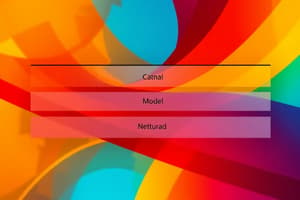Podcast
Questions and Answers
What is the main purpose of the Network Layer in the OSI model?
What is the main purpose of the Network Layer in the OSI model?
- Error-free transfer of data
- Data encryption and decryption
- Segmentation and reassembly of data
- Routing and congestion control (correct)
What is the primary function of NAT (Network Address Translation)?
What is the primary function of NAT (Network Address Translation)?
- To encrypt data packets
- To route traffic between subnets
- To translate public IP addresses to private IP addresses (correct)
- To assign IP addresses to devices
Which protocol is responsible for assigning IP addresses dynamically to devices on a network?
Which protocol is responsible for assigning IP addresses dynamically to devices on a network?
- DHCP (correct)
- TCP
- DNS
- UDP
What is the purpose of the DNS (Domain Name System) protocol?
What is the purpose of the DNS (Domain Name System) protocol?
Which TCP port is commonly used for HTTPS (Hypertext Transfer Protocol Secure) connections?
Which TCP port is commonly used for HTTPS (Hypertext Transfer Protocol Secure) connections?
A company has a private IP address range of 10.0.0.0/8 and wants to connect to the internet. What technology would be used to allow this connection?
A company has a private IP address range of 10.0.0.0/8 and wants to connect to the internet. What technology would be used to allow this connection?
What is the purpose of the 192.168.0.0/16 IP address range in a network?
What is the purpose of the 192.168.0.0/16 IP address range in a network?
A network administrator wants to divide a network into smaller sub-networks to improve network performance. What technique would be used to achieve this?
A network administrator wants to divide a network into smaller sub-networks to improve network performance. What technique would be used to achieve this?
Which protocol is used to resolve hostnames to IP addresses on the internet?
Which protocol is used to resolve hostnames to IP addresses on the internet?
What is the primary function of the OSI Model's Network Layer?
What is the primary function of the OSI Model's Network Layer?
Flashcards are hidden until you start studying
Study Notes
Network Topology
- Physical and logical arrangement of devices and connections in a network
- Types: Bus, Star, Ring, Mesh, Tree, Hybrid
OSI Model
- 7-layered framework for designing and implementing computer networks
- Layers:
- Physical (Layer 1)
- Data Link (Layer 2)
- Network (Layer 3)
- Transport (Layer 4)
- Session (Layer 5)
- Presentation (Layer 6)
- Application (Layer 7)
IP Addressing
- Unique identifier for devices on a network
- Classes: A, B, C, D, E (A, B, and C are used for public networks)
- Private IP addresses:
- 10.0.0.0 - 10.255.255.255
- 172.16.0.0 - 172.31.255.255
- 192.168.0.0 - 192.168.255.255
- Public IP addresses: assigned by Internet Service Providers (ISPs)
Subnetting
- Dividing a larger network into smaller sub-networks
- Subnet mask: used to determine the scope of a subnet
- Benefits: improved network efficiency, reduced traffic, and increased security
IPs and NAT
- Network Address Translation (NAT): allows multiple devices to share a single public IP address
- Private IP addresses are translated to a public IP address for internet communication
Routing
- Process of forwarding data packets between networks
- Routers: devices that connect multiple networks and forward data packets
Protocols and Ports
- Communication languages and rules used by devices on a network
- Common protocols: TCP, UDP, HTTP, FTP, DNS, DHCP
- Ports: 0-65535, with 0-1023 being well-known ports (e.g., 80 for HTTP, 21 for FTP)
DHCP
- Dynamic Host Configuration Protocol: assigns temporary IP addresses to devices on a network
- Reduces network administration and IP address conflicts
DNS
- Domain Name System: translates domain names to IP addresses
- Enables users to access websites and resources using easy-to-remember domain names instead of IP addresses
Network Topology
- Physical and logical arrangement of devices and connections in a network
- Types: Bus, Star, Ring, Mesh, Tree, Hybrid
OSI Model
- 7-layered framework for designing and implementing computer networks
- Layers:
- Physical (Layer 1)
- Data Link (Layer 2)
- Network (Layer 3)
- Transport (Layer 4)
- Session (Layer 5)
- Presentation (Layer 6)
- Application (Layer 7)
IP Addressing
- Unique identifier for devices on a network
- Classes: A, B, C, D, E (A, B, and C are used for public networks)
- Private IP addresses:
- 10.0.0.0 - 10.255.255.255
- 172.16.0.0 - 172.31.255.255
- 192.168.0.0 - 192.168.255.255
- Public IP addresses: assigned by Internet Service Providers (ISPs)
Subnetting
- Dividing a larger network into smaller sub-networks
- Subnet mask: used to determine the scope of a subnet
- Benefits: improved network efficiency, reduced traffic, and increased security
IPs and NAT
- Network Address Translation (NAT): allows multiple devices to share a single public IP address
- Private IP addresses are translated to a public IP address for internet communication
Routing
- Process of forwarding data packets between networks
- Routers: devices that connect multiple networks and forward data packets
Protocols and Ports
- Communication languages and rules used by devices on a network
- Common protocols: TCP, UDP, HTTP, FTP, DNS, DHCP
- Ports: 0-65535, with 0-1023 being well-known ports (e.g., 80 for HTTP, 21 for FTP)
DHCP
- Dynamic Host Configuration Protocol: assigns temporary IP addresses to devices on a network
- Reduces network administration and IP address conflicts
DNS
- Domain Name System: translates domain names to IP addresses
- Enables users to access websites and resources using easy-to-remember domain names instead of IP addresses
Studying That Suits You
Use AI to generate personalized quizzes and flashcards to suit your learning preferences.



